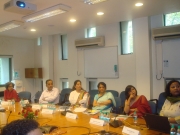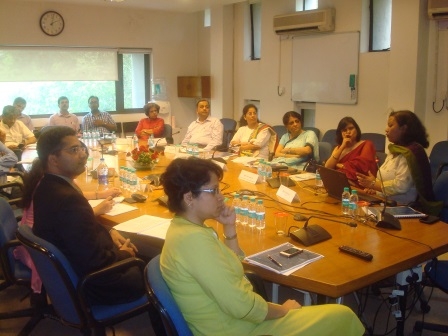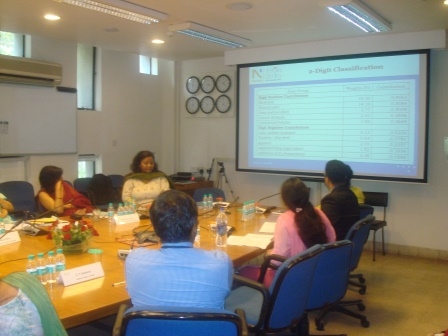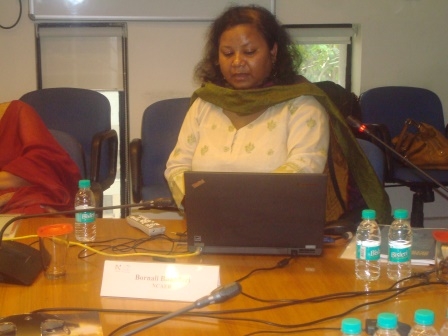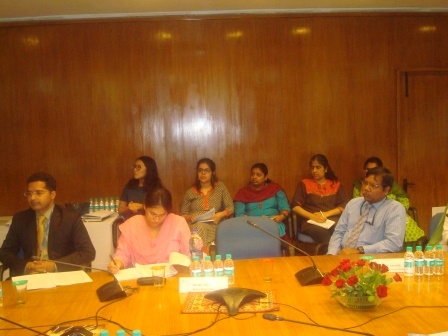NCAER’S Quarterly Review of the Economy May 2016
NCAER predicts GDP will grow at 7.7 percent in 2016-17
NCAER Team presented the Quarterly Review of the Economy at a seminar held at its Conference Room. The review covers the performance of the Economy in the 2015-16 and forecast for the year head.
NCAER’s annual model for GDP Market prices at 2011–12 prices estimates GDP growth rate of 7.6% for 2015 – 2016 and forecasts it at 7.7% for 2016–17. Growth in exports and imports, year-on-year, is projected at (-) 1.6% and (-) 0.6% respectively for 2016-17. Inflation (WPI) is projected at 0.9% for 2016-17. Current Account Balance as a percentage of GDP is projected at (-) 1.0% and Fiscal Deficit (centre) as a percentage of GDP at 3.5% for 2016-17.
The agriculture sector has witnessed feeble growth on account of drought for two successive years. The average rate of growth in the agricultural and allied sectors’ GDP for 2014-15 and 2015-16 has been a low 0.5%. Two consecutive years of sub-par monsoon have had a significant impact on the output of both food as well as non-food crops. IMD has predicted monsoon for 2016-17 at 106% of the Long Period Average (LPA) with a model error of ± 5%, which may have a positive impact on agriculture and thereby the economy.
In the industrial sector, the manufacturing sector after showing robust growth in the second quarter, has slowed down consistently in the third and fourth quarter. The Index of Industrial Production (IIP) recorded a 2.4% year-on-year (y-o-y) increase in the period in 2015-16 versus 2.8% in 2014-15. In the fourth quarter IIP Manufacturing was in recession (-1.1%) and the overall IIP barely grew by 0.2% on a y-o-y basis. In the fourth quarter, Capital goods grew by -15.4% and consumer non-durables by -3.9% on a y-o-y basis. The IIP Electricity sector continues to show buoyant growth since December 2015 and in March 2016, grew by 11.3% on a y-o-y basis. The IIP Mining also slowed down in March but for the overall year, it showed higher growth of 2.2% in 2015-16 versus 1.4%in 2014-15.
Leading indicators from the services sector in 2015-16:Q4 give mixed signals. Tourist arrivals grew at 10% on a y-o-y basis. Cargo traffic at major ports grew at 7.6% on a y-o-y basis in the fourth quarter of the last fiscal. Revenue earning goods traffic by railways contracted in the fourth quarter as well. Bank credit to the commercial sector showed a continuous increase in y-o-y growth rates from 8.8% 2015-16:Q1 to 11.2% in the fourth quarter. Domestic passenger air traffic shows robust growth in 2015-16(21.2%) versus 2014-15(13.8%). Both services receipts (-12.6%) and payments (-9.9%), published by the RBI, showed a continuous decline for the fourth consecutive month in February 2016.
In the external sector, merchandise imports declined by 15.3 per cent to US$ 379.6 billion on account of a 40.2% fall in the value of oil imports. Non-oil imports too fell by 4.1%, as a result of which the thereby trade deficit narrowed down to US$ 118.5 billion, a decrease of 14% over the previous year, of 2014-15. Growth in exports has been consistently negative ever since December 2014.
The BSE Sensex fell by 2% in 2015-16 over 2014-15 and rupee-dollar exchange rate depreciated by 7% in 2015-16. The Reserve Bank of India launched a plethora of measures to boost liquidity, in addition to cutting the policy rate by 25 basis points, to a five year low of 6.5 per cent. The liquidity measures are aimed at inducing more effective monetary policy transmission and further reduction of bank lending rates.
Retail inflation, measured by the consumer Price Index (CPI) fell to a six month low of 4.83% in March, 2016. Retail food inflation fell from 5.30% to 5.21%.The combination of lower oil prices and a good monsoon is expected to rein in inflation.
On the fiscal front, the Budget of 2016–17 aims to achieve the deficit target of 3.5 per cent of GDP, in line with the predictions of the NCAER model.
About the Quarterly Review of the Economy
The Quarterly Review has been designed to meet the needs of policy makers, corporates and others interested in tracking the latest developments in the Indian economy. It provides an analysis of current policies and tracks developments in both the domestic as well as the global economies. The growth forecasts of NCAER are objective and are widely quoted and referred to in both the Indian as well as the international media. An integral part of the Quarterly Review is the State of Economy Seminars, organised quarterly at NCAER, which bring together policy makers, industry leaders and researchers at one forum.






